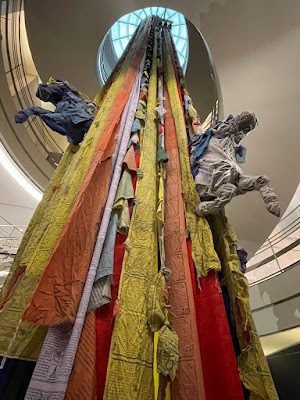
After twenty inspired and inspiring years, the Rubin Museum of Art is closing October 6th. I went for a farewell visit today, appreciating their final exhibition's characteristically lovely way of activating their collection. Contemporary Himalayan artists were invited to respond to particular objects from the collection, which were then exhibited near the new work (or in a few cases, the new with the old).
(Works by Pema "Tintin" Tshering, Charwei Tsai, Jasmine Rajbhandari)
 Their curation has always been remarkable, allowing intimate and deeply meaningful encounters with art that is, after all, religiously charged, and this was no exception. They're making the best of closing, inviting us to share their excitement about becoming a "global museum" - a virtual museum? traveling exhibits? But these re-encounters with the collection - like this exquisite 13th/14th century Nepalese Avalokitesvara - made the loss of this museum even sadder.
Their curation has always been remarkable, allowing intimate and deeply meaningful encounters with art that is, after all, religiously charged, and this was no exception. They're making the best of closing, inviting us to share their excitement about becoming a "global museum" - a virtual museum? traveling exhibits? But these re-encounters with the collection - like this exquisite 13th/14th century Nepalese Avalokitesvara - made the loss of this museum even sadder.
I learned much of what I think I know about museum curation from a relationship with the Rubin which has included countless class visits and collaborations - click the tag "Rubin Museum of Art" at the bottom of this post for many such edifying episodes, including the one, in 2011, from which Atta Kim's melting ice Buddha at the top of this post hails.
 Looking back on it I'm reminded of the wisdom, including wisdom about traditions of accepting and even welcoming change, that the museum has always offered. Asha Kama Wangdi has filled the six-storey stairwell of the museum with a
column of discarded prayer flags, known as "wind horses," and crafted
actual horses emerging from them. Maybe their work is done in this space.
Looking back on it I'm reminded of the wisdom, including wisdom about traditions of accepting and even welcoming change, that the museum has always offered. Asha Kama Wangdi has filled the six-storey stairwell of the museum with a
column of discarded prayer flags, known as "wind horses," and crafted
actual horses emerging from them. Maybe their work is done in this space.
There has always something terrifically embodied about the experiences they offered, engaging all the senses, the space, and the feelings we bring and take from it, and this final show is no exception.
 In the Tibetan Shrine Room, their most immersive space, there's a piece of broken concrete with the words PLEASE TOUCH. It's a work by John Tsung called "神代/Divine Generation" and it quivers. It's a fragment from the foundation of the building, and has been wired up with 1000 feet of cables, inscribed with the Heart Sutra, which encircle the museum's walls and stairwells like a nervous system, or prayer beads. Touching it you feel the vibrations of people moving through the whole building. How lovely, how deep! I can feel that tingle in my hand even now.
In the Tibetan Shrine Room, their most immersive space, there's a piece of broken concrete with the words PLEASE TOUCH. It's a work by John Tsung called "神代/Divine Generation" and it quivers. It's a fragment from the foundation of the building, and has been wired up with 1000 feet of cables, inscribed with the Heart Sutra, which encircle the museum's walls and stairwells like a nervous system, or prayer beads. Touching it you feel the vibrations of people moving through the whole building. How lovely, how deep! I can feel that tingle in my hand even now.

One more work, which also allows us to accept the passing of the museum, at least in this form, itself a response to the Shrine Room. Kunsang Gyatso's "Goddess of Tangerine," we learn, suggests an alternate universe in which tangerines are worshiped because of their extinction ... us[ing] the dried tangerines to metaphorically visualize time and impermanence ... I'm not sure if Gyatso has Thich Nhat Hanh's tangerine meditation in mind. In any case, it's witty, allows us to acknowledge the unthinkability of loss (could tangerines disappear?!) while conjuring hope through its beauty.
Thank you, Rubin Museum, for two decades of wonder.


